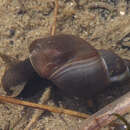en
names in breadcrumbs


Hygrophila is a taxonomic superorder of air-breathing freshwater snails, aquatic pulmonate gastropod mollusks within the clade Panpulmonata.[2] [1]
The families in this clade are basically air-breathing freshwater snails including freshwater limpets. The three families with the greatest number of species are the Lymnaeidae (pond snails), the Planorbidae (ramshorn snails) and the Physidae (pouch or bubble snails). These are found in ponds, creeks, ditches, and shallow lakes nearly worldwide.
The snails in this clade have their eyes located at the base of their tentacles, rather than at the tips, as in the true land snails Stylommatophora. They have shells that are thin, translucent, and relatively colorless, and they lack an operculum.
In the older taxonomy of the Gastropoda (Ponder & Lindberg, 1997) these families were placed in the suborder Basommatophora.
Hygrophila has been a clade in the informal group Basommatophora within the Pulmonata.[3]
Clade Hygrophila:
Note: what was previously the family Ancylidae has been demoted in the new taxonomy to the status of tribe Ancylini Rafinesque, 1815 within the subfamily Planorbinae Rafinesque, 1815 of the family Planorbidae Rafinesque, 1815.
Basommatophora (Siphonarioidea and Amphiboloidea and Hygrophila) have been found polyphyletic and so Jörger et al. (2010)[2] have moved Hygrophila to Panpulmonata.
A comprehensive molecular phylogenetic analysis of Hygrophila based on 3112 sites of the large subunit and 5.8S ribosomal RNA genes resulted in a proposal of a new taxonomic revision of the group.[4]
Hygrophila is a taxonomic superorder of air-breathing freshwater snails, aquatic pulmonate gastropod mollusks within the clade Panpulmonata.
The families in this clade are basically air-breathing freshwater snails including freshwater limpets. The three families with the greatest number of species are the Lymnaeidae (pond snails), the Planorbidae (ramshorn snails) and the Physidae (pouch or bubble snails). These are found in ponds, creeks, ditches, and shallow lakes nearly worldwide.
The snails in this clade have their eyes located at the base of their tentacles, rather than at the tips, as in the true land snails Stylommatophora. They have shells that are thin, translucent, and relatively colorless, and they lack an operculum.
Hygrophila es un clado taxonómica de los caracoles de agua dulce que respiran aire, moluscos gasterópodos pulmonados acuáticos dentro del clado Panpulmonata.
Estas familias fueron colocados en el suborden Basommatophora (Taxonomía de Gastropoda (Ponder & Lindberg, 1997)).
Ha sido un clado en el grupo informal Basommatophora dentro de la Pulmonata.
Clado Hygrophila:
Basommatophora (Siphonarioidea y Amphiboloidea y Hygrophila) se ha encontrado en el grupo polifilético y así Jörger trasladó de Hygrophila a Panpulmonata.
Hygrophila es un clado taxonómica de los caracoles de agua dulce que respiran aire, moluscos gasterópodos pulmonados acuáticos dentro del clado Panpulmonata.
Les Hygrophila sont un super-ordre (ou un ordre selon les classifications) de mollusques gastéropodes de l'infra-classe des Pulmonata.
Ce taxon correspond à l'ancien groupe des Basommatophora, une fois ôtés les groupes discutés des Amphiboloidea et Siphonarioidea[1].
Selon World Register of Marine Species (13 mai 2016)[1] :
Les Hygrophila sont un super-ordre (ou un ordre selon les classifications) de mollusques gastéropodes de l'infra-classe des Pulmonata.
Hygrophila Férussac, 1822 è un superordine di molluschi gasteropodi d'acqua dolce.[1]
Il raggruppamento comprende tutte le chiocciole d'acqua dolce in grado di respirare l'aria. Gli occhi di questi molluschi sono posti alla base delle loro appendici cefaliche, anziché alla punta di esse, come avviene negli Stylommatophora. Sono dotati di conchiglia sottile, traslucida, priva di opercolo, con un'ampia variabilità di forme (coniche, spiraliformi, discoidali, patelliformi), con avvolgimento destrorso o sinistrorso.[2]
Questi molluschi assimilano l'ossigeno atmosferico attraverso la superficie interna del loro mantello, dove trattengono una bolla d'aria, che deve essere rinnovata periodicamente.[3]
Il raggruppamento ha una distribuzione cosmopolita essendo diffuso in stagni, ruscelli, fossati e laghi poco profondi di tutti i continenti eccetto l'Antartide.
Il superordine Hygrophila comprende due superfamiglie e otto famiglie:[1]
Nelle classificazioni precedenti le famiglie di questo taxon erano inquadrate tra i Basommatophora[4][5], raggruppamento rivelatosi polifiletico[6].
Hygrophila Férussac, 1822 è un superordine di molluschi gasteropodi d'acqua dolce.
De Hygrophila zijn een clade van zoetwaterslakken (Gastropoda).
Jörger et al. (2010)[1] hebben de hoofdgroepen binnen de Heterobranchia opnieuw ingedeeld. Ze creëerden de nieuwe clades Euopisthobranchia en Panpulmonata.[1]
Onderstaande cladogram toont de relatie binnen de Heterobranchia zoals voorgesteld door Jörger et al. (2010):[1]
HeterobranchiaLower Heterobranchia (inclusief Acteonoidea) - Lower Heterobranchia vormt geen clade in de studie door Jörger et al. (2010):[1]
Cephalaspidea s.s.
Hygrophila
In detail is de taxonomische indeling van de clade als volgt:[2]
Hygrophila is de naam van een orde van slakken (Gastropoda). Deze indeling wordt niet meer door alle moderne auteurs geaccepteerd; veel auteurs maken tegenwoordig gebruik van een indeling in clades.[1][2]
Hygrophila is de naam van een orde van slakken (Gastropoda). Deze indeling wordt niet meer door alle moderne auteurs geaccepteerd; veel auteurs maken tegenwoordig gebruik van een indeling in clades.
喜濕螺類(學名:Hygrophila)是生物分类学的一個支序,屬於異鰓類直神經類泛有肺類支序,包括有所有會呼吸的淡水螺及所有水生的真有肺類軟體動物,由Jörger et al.於2010年10月建立[2]。2017年12月,本支序成為了總目級分類單元,即喜濕螺總目[3]。
本支序之下的所有科皆為會呼吸的淡水螺,包括淡水帽貝。 本分類最多不同物種的三個科分別為:
這些物種可在池塘、小溪、溝渠及淺湖中發現,遍及全世界。
本支序物種的眼睛均長在觸角的底部,而不是頂部。這一點跟陸生的柄眼類物種(Stylommatophora)相當。牠們的殼薄而透明,看起來似乎無色,而且沒有口蓋覆蓋。
根據腹足纲分类表 (1997年),現時本支序的科原來都放在基眼亚目(Basommatophora Keferstein in Bronn, 1864)之下。
根據2005年的《布歇特和洛克羅伊的腹足類分類》,原來的基眼亚目在2005年的分類裡成為了有肺目之下的一個非正式群組,而本支序仍然在基眼亞目之下[4]。
喜濕螺類支序:
基眼類(即:Siphonarioidea、Amphiboloidea及喜濕螺類)確認為並系群,為保持分類的單系性,Jörger et al. (2010)[2]把本支序連同其他相關的分類合併成為泛有肺類(Panpulmonata)支序。
根據2017年的《布歇特等人的腹足類分類》,本分類支序成為了Tectipleura Subterclass之下的一個總目級分類單元[3][1]。過往的基眼目被認為是喜濕螺總目的異名,儘管昔日的基眼目所包含的分類單元更多。
原來的四個總科現時綜合成為下列兩個總科[3]:
喜濕螺類(學名:Hygrophila)是生物分类学的一個支序,屬於異鰓類直神經類泛有肺類支序,包括有所有會呼吸的淡水螺及所有水生的真有肺類軟體動物,由Jörger et al.於2010年10月建立。2017年12月,本支序成為了總目級分類單元,即喜濕螺總目。
本支序之下的所有科皆為會呼吸的淡水螺,包括淡水帽貝。 本分類最多不同物種的三個科分別為:
椎实螺科 扁卷螺科 膀胱螺科這些物種可在池塘、小溪、溝渠及淺湖中發現,遍及全世界。
本支序物種的眼睛均長在觸角的底部,而不是頂部。這一點跟陸生的柄眼類物種(Stylommatophora)相當。牠們的殼薄而透明,看起來似乎無色,而且沒有口蓋覆蓋。
히그로필라류(Hygrophila)는 공기 호흡하는 민물 달팽이 분류군 중의 하나로, 범유폐류에 속하는 수생 유폐류의 복족류 연체동물이다.[1]
이 분류군에 있는 과들은 민물 삿갓조개류를 포함하여 기본적으로 공기 호흡하는 민물 달팽이이다. 종의 수가 가장 많은 3개 과는 물달팽이과, 또아리달팽이과 그리고 왼돌이물달팽이과이다. 이 종들은 못, 샛강, 개천, 얕은 호수 등 거의 전 세계에서 발견된다.
이 분류군에 있는 달팽이들은 눈이 육상의 참달팽이 병안류처럼 촉각 끝단보다는 촉각 하부에 위치한다. 얇고, 반투명의 비교적 무채색의 조가비 껍질을 지니고 있으며, 덮개딱지가 없다.
이전 분류 체계인 1997년 복족류 분류(폰더 & 린더버그)는 이들 과를 기안아목으로 분류했다.
히그로필라류를 유폐류 내의 비공식군 기안류에 속하는 분류군의 하나로 분류했다.[2]
참고: 이전 분류 체계의 민물삿갓조개과 (Ancylidae)는 새 분류 체계에서 또아리물달팽이과(Planorbidae)의 또아리물달팽이아과(Planorbinae)에 속하는 민물삿갓조개족(Ancylini)으로 강등되었다.
기안류(고랑따개비상과, 암피볼라상과, 히그로필라류)가 다계통군임이 밝혀짐에 따라, 2010년 요르거(Jörger)와 그의 공저자들은[1] 히그로필라류를 범유폐류로 옮겼다.
2010년 요르거(Jörger) 등이 제안한 분기도는 이새류의 계통분류학적 관계를 아래와 같이 보여준다.[1]
이새류하이새류 (비자고둥상과 포함) - 하이새류는 요르거(Jörger) 등의 연구(2010년)에서는 별도의 분기군을 형성하지 않는다.[1]
직신경류 진후새류두순류 s.s.
범유폐류 진유폐류